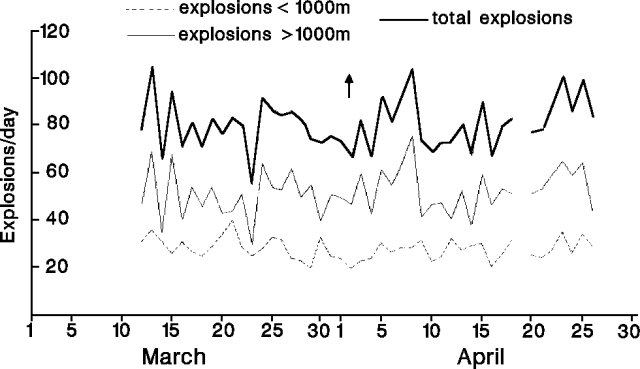Report on Santa Maria (Guatemala) — May 1992
Bulletin of the Global Volcanism Network, vol. 17, no. 5 (May 1992)
Managing Editor: Lindsay McClelland.
Santa Maria (Guatemala) Frequent explosions feed small ash columns; continued erosion threatens vent area
Please cite this report as:
Global Volcanism Program, 1992. Report on Santa Maria (Guatemala) (McClelland, L., ed.). Bulletin of the Global Volcanism Network, 17:5. Smithsonian Institution. https://doi.org/10.5479/si.GVP.BGVN199205-342030
Santa Maria
Guatemala
14.757°N, 91.552°W; summit elev. 3745 m
All times are local (unless otherwise noted)
The dome was observed from the old "Hotel Magermann" site and the Santiaguito Volcano Observatory (NW of and 7 km S of the dome, respectively) during 21-24 May fieldwork by Michigan Technological Univ and INSIVUMEH scientists. Between 50 and 100 explosions occurred daily at Caliente vent (figure 24), typically producing relatively weak vertical columns to 500-2,000 m height. The plume was white to light gray, with a small convecting section (100-300 m high) at the base. Fine ash observed several kilometers from the vent consisted of dense, pulverized dacite and fragments of plagioclase; the eruptions were probably phreatic. Between explosions, passive gas emissions rose several hundred meters.
 |
Figure 24. Daily number of explosions recorded seismically at Santiaguito, March-April 1992. The arrow marks an unusually strong eruptive event and pyroclastic flow. Prepared by INSIVUMEH. |
Several small, gray, vertical plumes were observed rising from near the SE base of Caliente, probably resulting from collapse at the front of a block lava flow. Although inclement weather prevented closer observation, plume locations suggested that the block lava flow had not progressed far since observations in late November 1991.
An extensive network of gullies, first observed on the N slope of Santiaguito in January 1990, has extended E to include Caliente vent. Rapid mass wasting, which began on the central dome (El Monje), resulted in numerous gullies that coalesced, greatly changing the appearance of the N flank. Scientists noted that continued erosion could severely undercut the large spines on Caliente's upper N flank, possibly causing their collapse and a subsequent rapid depressurization of the shallow magma system beneath Caliente. They warned that sudden depressurization could produce an extremely powerful pyroclastic eruption at the dome. One of INSIVUMEH's goals during its "Decade Volcano" program at Santiaguito is to monitor erosion processes and quantify mass-wasting rates at the dome.
The onset of the rainy season has annually caused an increased number of lahars in drainages S of the volcano. On 20 May, a lahar swept 12 km down the Río Nimá II. Fresh lahar deposits (about 1 m thick) found on terraces above the river's central channel indicated that the lahar was at least 2-3 m thick and 15-30 m wide.
Geological Summary. Symmetrical, forest-covered Santa María volcano is part of a chain of large stratovolcanoes that rise above the Pacific coastal plain of Guatemala. The sharp-topped, conical profile is cut on the SW flank by a 1.5-km-wide crater. The oval-shaped crater extends from just below the summit to the lower flank, and was formed during a catastrophic eruption in 1902. The renowned Plinian eruption of 1902 that devastated much of SW Guatemala followed a long repose period after construction of the large basaltic andesite stratovolcano. The massive dacitic Santiaguito lava-dome complex has been growing at the base of the 1902 crater since 1922. Compound dome growth at Santiaguito has occurred episodically from four vents, with activity progressing E towards the most recent, Caliente. Dome growth has been accompanied by almost continuous minor explosions, with periodic lava extrusion, larger explosions, pyroclastic flows, and lahars.
Information Contacts: Michael Conway, Michigan Technological Univ; Otoniel Matías, INSIVUMEH.

